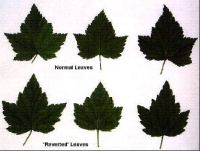Blackcurrent reversion virus
From Allotments4All
- Disease type: Virus
- Family: Comoviridae
- Scientific name: Blackcurrant reversion association virus (subgroup C)
- English name: Blackcurrant reversion virus
Signs of infestation: No visible signs.
Symptoms of infestation: Crops of fruit are severely reduced. The leaves show a change in shape, and some may be yellowish in colour. The plant may produce more ‘leggy’ shoots. A decrease in hairiness of the flower sometimes occurs. The plant appears less vigorous.
Biology, reproduction and spread, and the relationship of its spread to its biology: This is an obligate parasite virus that attacks blackcurrant, Ribes nigrum and causes reversion disease. It is spread by a mite vector, the blackcurrant gall mite, or big bud mite, Cecidophyopsis ribis. The virus is a microscopic particle that invades the host plant, where its RNA (Ribonucleic acid) changes the activity of the plants cells, disrupting the plant’s normal processes. The virus will continue to live in its host until the natural death of the host occurs, at which point the virus will die unless it has already been spread to another blackcurrant host by a vector.
Prevention and control treatments and methods.
Physical and cultural: Check plants regularly for signs and symptoms of infestation. Pick off and destroy any enlarged buds as soon as they are apparent. Destroy infected plants. Avoid planting bushes where there is a known infected area. Plant cultivars with resistance to the disease, such as Ribes nigra ‘Ben Hope’ and ‘Ben Gairn’. Always purchase fresh, certified virus-free plants. Virus-free plants are propagated by micro-propagation methods using the apical meristem tissue; vegetative propagation by cuttings will mean that the cutting carries the virus. The mite Cecidophyopsis ribis dislikes high humidity, and overhead irrigation will discourage its activity. Encourage natural predators like lacewings, Chrysopa spp. by providing food sources such as poached-egg plants, Limnanthes douglasii.
Biological – together with benefits and limitations: None
Chemical: None for the virus, but the mite Cecidophyopsis ribis may be controlled by spraying with spray a product containing fenpropathrin which will act as a contact acaricide.
Legislative: None specific, but the general principle of the Plant Health (Great Britain) Order 1993 would prevent the movement of diseased plants.
How the disease affects the health and vitality of the host plant: The disease does not kill the plant, but the plant suffers a general lack of vigour, its life is shortened, and changes in its cellular structure affect its usefulness. In the case of blackcurrant this means significantly reduced crops.


